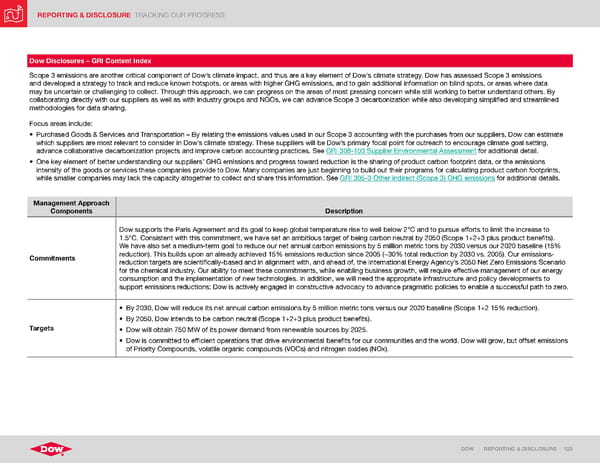REPORTING & DISCLOSURE TRACKING OUR PROGRESS DOW | REPORTING & DISCLOSURE | 123 Dow Disclosures – GRI Content Index Scope 3 emissions are another critical component of Dow’s climate impact, and thus are a key element of Dow’s climate strategy. Dow has assessed Scope 3 emissions and developed a strategy to track and reduce known hotspots, or areas with higher GHG emissions, and to gain additional information on blind spots, or areas where data may be uncertain or challenging to collect. Through this approach, we can progress on the areas of most pressing concern while still working to better understand others. By collaborating directly with our suppliers as well as with industry groups and NGOs, we can advance Scope 3 decarbonization while also developing simplified and streamlined methodologies for data sharing. Focus areas include: • Purchased Goods & Services and Transportation – By relating the emissions values used in our Scope 3 accounting with the purchases from our suppliers, Dow can estimate which suppliers are most relevant to consider in Dow’s climate strategy. These suppliers will be Dow’s primary focal point for outreach to encourage climate goal setting, advance collaborative decarbonization projects and improve carbon accounting practices. See GRI 308-103 Supplier Environmental Assessment for additional detail. • One key element of better understanding our suppliers’ GHG emissions and progress toward reduction is the sharing of product carbon footprint data, or the emissions intensity of the goods or services these companies provide to Dow. Many companies are just beginning to build out their programs for calculating product carbon footprints, while smaller companies may lack the capacity altogether to collect and share this information. See GRI 305-3 Other indirect (Scope 3) GHG emissions for additional details. Management Approach Components Description Commitments Dow supports the Paris Agreement and its goal to keep global temperature rise to well below 2°C and to pursue efforts to limit the increase to 1.5°C. Consistent with this commitment, we have set an ambitious target of being carbon neutral by 2050 (Scope 1+2+3 plus product benefits). We have also set a medium-term goal to reduce our net annual carbon emissions by 5 million metric tons by 2030 versus our 2020 baseline (15% reduction). This builds upon an already achieved 15% emissions reduction since 2005 (~30% total reduction by 2030 vs. 2005). Our emissions- reduction targets are scientifically-based and in alignment with, and ahead of, the International Energy Agency’s 2050 Net Zero Emissions Scenario for the chemical industry. Our ability to meet these commitments, while enabling business growth, will require effective management of our energy consumption and the implementation of new technologies. In addition, we will need the appropriate infrastructure and policy developments to support emissions reductions; Dow is actively engaged in constructive advocacy to advance pragmatic policies to enable a successful path to zero. Targets • By 2030, Dow will reduce its net annual carbon emissions by 5 million metric tons versus our 2020 baseline (Scope 1+2 15% reduction). • By 2050, Dow intends to be carbon neutral (Scope 1+2+3 plus product benefits). • Dow will obtain 750 MW of its power demand from renewable sources by 2025. • Dow is committed to efficient operations that drive environmental benefits for our communities and the world. Dow will grow, but offset emissions of Priority Compounds, volatile organic compounds (VOCs) and nitrogen oxides (NOx).
 ESG Report | Dow Page 122 Page 124
ESG Report | Dow Page 122 Page 124